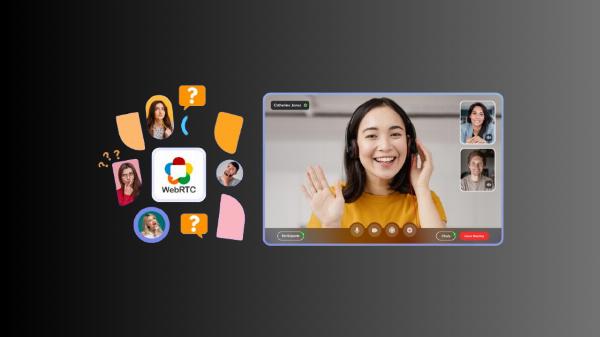In today’s digital era, Web Real-Time Communication (WebRTC) has emerged as a transformative technology enabling real-time audio, video, and data sharing across web browsers and mobile applications without the need for plugins. From telehealth and remote education to customer support and team collaboration, WebRTC is revolutionizing various industries. This blog will delve into compelling case studies of successful In today’s digital era, Web Real-Time Communication (WebRTC) has emerged as a transformative technology enabling real-time audio, video, and data sharing across web browsers and mobile applications without the need for plugins. From telehealth and remote education to customer support and team collaboration, WebRTC is revolutionizing various industries. This blog will delve into compelling case studies of successful WebRTC application developments and their significant impacts.
Understanding WebRTC
Before diving into the case studies, it’s crucial to grasp what WebRTC entails. WebRTC is an open-source project that provides web applications and sites with Real-Time Communications (RTC) capabilities via simple JavaScript APIs. It enables seamless peer-to-peer communication, thus facilitating real-time video, voice, and data transmission.
Case Study 1: Telehealth Platform
Background
A leading healthcare provider sought to develop a telehealth platform to offer virtual consultations, remote patient monitoring, and follow-up care. They aimed to provide a seamless, secure, and reliable communication channel between doctors and patients.
Development
The development team integrated WebRTC to enable high-quality video and audio calls directly from the web browser. They incorporated features such as:
-
Video Conferencing: Facilitating face-to-face consultations between doctors and patients.
-
Data Sharing: Enabling the exchange of medical reports, prescriptions, and diagnostic images.
-
Security: Implementing end-to-end encryption to ensure the confidentiality of patient data.
Impact
The telehealth platform significantly improved access to healthcare services, particularly in rural and underserved areas. It reduced the need for in-person visits, saving time and travel costs for patients. The platform also enhanced the efficiency of healthcare providers by allowing them to manage consultations remotely.
Case Study 2: Online Education Platform
Background
A prominent educational institution aimed to create an online education platform to facilitate remote learning for students worldwide. Our goal was to create an interactive and engaging learning experience.
Development
WebRTC was employed to develop a robust online education platform with features such as:
-
Live Classes: Streaming live video lectures with real-time interaction between instructors and students.
-
Collaborative Tools: Implement features like virtual whiteboards, screen sharing, and group discussions.
-
Recording and Playback: Allowing students to record sessions for later review.
Impact
The platform enabled the institution to reach a global audience, providing high-quality education to students regardless of their location. It enhanced student engagement through interactive tools and facilitated better learning outcomes. Additionally, the ability to record and replay sessions provided students with a valuable resource for studying.
Case Study 3: Customer Support System
Background
A major e-commerce company wanted to enhance its customer support system by enabling real-time communication between customers and support agents. The aim was to improve customer satisfaction and resolve issues more efficiently.
Development
The WebRTC-powered customer support system included the following features:
-
Video Calls: Enabling face-to-face interactions between customers and support agents.
-
Screen Sharing: Allowing agents to guide customers through troubleshooting steps.
-
Instant Messaging: Providing a chat feature for quick text-based support.
Impact
The real-time communication features significantly improved the customer support experience. Customers could resolve issues faster and more effectively, leading to higher satisfaction rates. The visual and interactive support reduced the number of follow-up interactions required, thus increasing the efficiency of the support team.
Case Study 4: Team Collaboration Tool
Background
A growing tech company needed a robust team collaboration tool to facilitate remote work and improve internal communication. The objective was to ensure seamless collaboration among team members spread across different locations.
Development
The WebRTC-based collaboration tool included:
-
Video Conferencing: Allowing teams to conduct virtual meetings with high-quality audio and video.
-
Screen Sharing and File Sharing: Enabling team members to share their screens and files for better collaboration.
-
Real-time Messaging: Providing instant messaging capabilities for quick communication.
Impact
The collaboration tool significantly enhanced the productivity and efficiency of remote teams. It bridged the communication gap and allowed for real-time collaboration, fostering a more connected and engaged workforce. The tool also helped in maintaining the company culture by facilitating regular virtual meetings and interactions.
Read More: 5 Facts You Should Know About WebRTC Mobile App Development
Conclusion
These case studies highlight the transformative impact of WebRTC application developments across various industries. From healthcare and education to customer support and team collaboration, WebRTC enables innovative solutions that enhance communication, improve efficiency, and deliver superior user experiences.
Choosing the right WebRTC development partner is crucial to leveraging the full potential of this technology. By examining successful implementations, businesses can gain valuable insights into the benefits and possibilities of WebRTC applications. Whether you're looking to improve customer interactions, enhance remote learning, or foster team collaboration, WebRTC offers a versatile and powerful solution.





